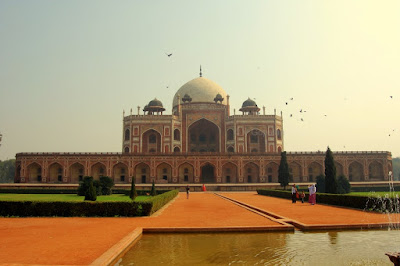
Many may not know that before Shah Jahan, it was Hamida Banu Begum who built a memorial for the spouse. But Taj Mahal became famous because of its architectural beauty, grandeur and excellence!
If Taj Mahal was built by Shah Jahan for his wife, Humayun’s tomb was built for the Mughal Emperor Humayun by his wife Hamida Banu Begum! This is an edifice built using red sand stones and is the first of its kind in India. The architect of this tomb is Mirak Mirza Ghiyath from Persia.

It also has the distinction of being the first garden-tomb in the Indian subcontinent. It is locaterd in Nizamuddin East in Delhi, India. In 1993 UNESCO declared it a World Heritage Site.

The complex encompasses the main tomb of the Emperor Humayun, which houses the graves of his wife, Hamida Begum, and also Dara Shikoh, son of the later Emperor Shah Jahan, as well as numerous other subsequent Mughals, including Emperor Jahandar Shah,
It is built on the banks of river Yamuna due to its proximity to Nizamuddin Dargah, the mausoleum of the celebrated Sufi saint of Delhi, Nizamuddin Auliva, who was much revered by the rulers of Delhi.

This tomb established some of the norms, which were later on followed by others. It is geometrically arranged in a garden crisscrossed by many water channels and it is supposed to resemble paradise! Subsequently such garden settings were also built in Delhi Red Fort and Taj Mahal. The architectural form of the building is Persian, especially its main chamber which shows some similarity with the tombs found in Persia. Humayun's tomb is the first Indian building to use the Persian double dome which is noteworthy for its harmonious proportions.

Although the architect of the tomb was from Persia, it has been observed that the distinctly Indian aspects of the tomb, such as the Hindu chattris (domed pavilions) that surround the central dome, set Humayun's tomb firmly in the Indo-Islamic tradition that was already emerging at the time.
A high wall surrounds the garden on three sides, the fourth side being bounded by what was once the bank of the river Jamna, which has since been diverted. The garden is divided into four parts by two bisecting water channels with paved walkways (khiyabans), which terminate at two gates: a main one in the southern wall, and a smaller one in the western wall.

As with later Mughal tombs, that of Humayun is set upon a podium or platform. The building is noteworthy for its inlaid tile work, carving embodying both Indian and Persian decorative elements, and its carved stone screens.
The coffin of Humayun is found in the central domed chamber, the head pointing south, and facing east according to Islamic practice. The vaulted chambers also contain coffins that were added later. The sex of each occupant is marked by a simple carved symbol: a box of writing instruments indicates a male, and a writing slate indicates a female. The coffins are not otherwise inscribed, but among them are known to be those containing the wives of Humayun, and several later Mughal emperors and princes.
